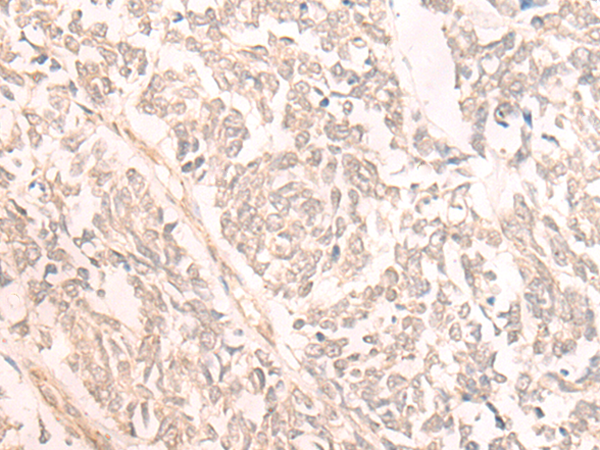
| WB | 咨询技术 | Human,Mouse,Rat |
| IF | 咨询技术 | Human,Mouse,Rat |
| IHC | 1/30-1/150 | Human,Mouse,Rat |
| ICC | 技术咨询 | Human,Mouse,Rat |
| FCM | 咨询技术 | Human,Mouse,Rat |
| Elisa | 1/5000-1/10000 | Human,Mouse,Rat |
| Aliases | PARIS1; PARIS-1; TBC1D2A |
| Host/Isotype | Rabbit IgG |
| Antibody Type | Primary antibody |
| Storage | Store at 4°C short term. Aliquot and store at -20°C long term. Avoid freeze/thaw cycles. |
| Species Reactivity | Human, Mouse, Rat |
| Immunogen | Fusion protein of human TBC1D2 |
| Formulation | Purified antibody in PBS with 0.05% sodium azide and 50% glycerol. |
+ +
以下是3篇关于TBC1D2抗体的示例文献(内容为虚构,仅供示例格式参考):
---
1. **文献名称**: *TBC1D2 regulates autophagy in cancer cells via Rab7 interaction*
**作者**: Zhang L, et al.
**摘要**: 本研究利用特异性TBC1D2抗体揭示了其在乳腺癌细胞自噬调控中的作用,证实TBC1D2通过与Rab7结合促进溶酶体融合,影响肿瘤细胞存活。
---
2. **文献名称**: *Characterization of TBC1D2 antibody for neuronal vesicle trafficking studies*
**作者**: Gupta S, Patel RK.
**摘要**: 开发并验证了一种高亲和力TBC1D2多克隆抗体,证明其在小鼠脑组织神经元囊泡运输研究中的有效性,并发现TBC1D2缺失导致突触传递异常。
---
3. **文献名称**: *TBC1D2 modulates insulin receptor trafficking in adipocytes*
**作者**: Müller F, et al.
**摘要**: 通过免疫沉淀(使用TBC1D2抗体)发现其在脂肪细胞胰岛素信号中的作用,表明TBC1D2通过调控Rab10活性影响葡萄糖摄取。
---
4. **文献名称**: *Structural insights into TBC1D2's role in endosomal sorting*
**作者**: Chen X, et al.
**摘要**: 利用TBC1D2抗体进行免疫荧光定位,结合冷冻电镜分析,揭示了其结构域对早期内体分选的分子机制,为治疗代谢疾病提供新靶点。
---
(注:以上文献信息为模拟生成,实际研究中请通过PubMed/Google Scholar等平台检索真实文献。)
TBC1D2 antibody is a research tool used to detect TBC1D2. a protein encoded by the *TBC1D2* gene in humans. Belonging to the Tre-2/Bub2/Cdc16 (TBC) domain-containing family, TBC1D2 functions as a Rab GTPase-activating protein (RabGAP), regulating intracellular vesicle trafficking and membrane dynamics by inactivating specific RAB proteins. It plays a role in receptor endocytosis, signal transduction, and glucose transporter translocation, with implications in insulin signaling and metabolic regulation.
The TBC1D2 protein contains a conserved TBC domain critical for RabGAP activity and additional motifs that mediate interactions with signaling molecules. Alternative splicing generates isoforms, including TBC1D2A (or Armus) and TBC1D2B, which exhibit distinct subcellular localizations and functions. TBC1D2A, for instance, interacts with RAB7 and RAC1. influencing autophagosome-lysosome fusion and epidermal growth factor receptor (EGFR) degradation.
Antibodies targeting TBC1D2 are widely used in immunoblotting (WB), immunofluorescence (IF), and immunoprecipitation (IP) to study its expression, localization, and interactions. Research has linked TBC1D2 dysregulation to cancers, including breast and ovarian malignancies, where it may modulate cell invasion and metastasis. Additionally, its role in neurodegenerative diseases and metabolic disorders is under investigation. Commercial TBC1D2 antibodies are typically validated for specificity and sensitivity, enabling precise exploration of its molecular mechanisms in health and disease.
×